What is a landslide? Types, causes, effects & prevention
by Andrew Lees, on September 09, 2021
A landslide is defined as the movement of soil, rock and debris down a slope due to the force of gravity. Classified by their movement, landslides can have detrimental effects on the environment, infrastructure and human life if preventative measures are not taken.
This guide explains what a landslide is, outlining the various types, the causes of a landslide, its effects, and the main landslide prevention techniques used in engineering and construction.
Use the links below to jump to the sections you’re most interested in:
- What is a landslide?
- Types of landslide movement
- What causes a landslide?
- The varying effects of landslides
- Preventing a landslide
- Repair of failed slopes
What is a landslide?
A landslide is the movement of rock, earth, or debris down a slope due to gravity. When the force of gravity on a slope surpasses the forces that resist movement, the slope fails, resulting in a landslide.
Landslides are a type of “mass wasting”, which is the name for any downslope movement of soil and/or rock under the direct influence of gravity. This movement of the landslide is caused by the self-weight of the material, under the force of gravity, and can take the form of falls, topples, sliding, spreading, or flows (mudflows or waste flows).
Types of landslide movement
There are many diverse types of landslides with varying sizes, shapes, movement speeds, and characteristics. Landslides are categorised by the type of movement involved, including falls, topples, slides and flows, and each often causes the same negative effects on their surroundings.
Falls
With vertical or steep slopes, such as cliffs, a landslide often takes the form of a fall – this occurs when material collapses from the slope, falls downwards, and accumulates at the base. As a result, we can recognise the occurrence of a fall and differentiate it from other landslide types by the accumulation of earth, rock, and debris at the bottom of a steep slope.
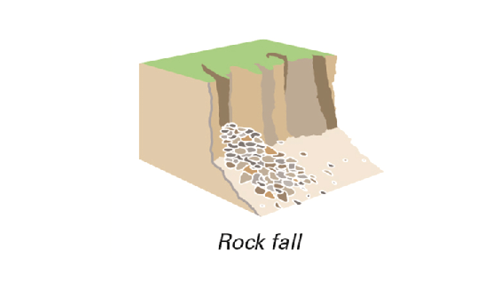.png)
Topples
As the name suggests, a topple is a type of landslide where the rock, earth or debris rotates forward away from the slope and literally topples downwards. Under normal circumstances, there will be an axis at or close to the bottom of the slope about which the rotation occurs.
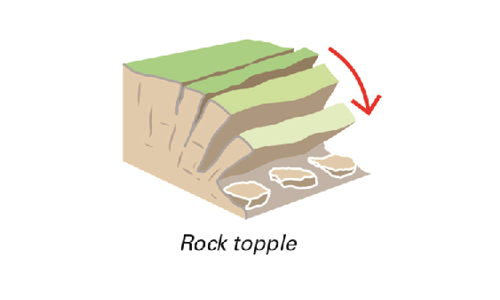.png)
Slides
In cases where a slide landslide occurs, the failure in the slope takes place at a depth below the surface. The material above this point then slides downwards along a slip surface (or ‘rupture’). This type of slide landslide can either be rotational or translational.
Rotational
We can spot rotational slides in cases where the slip surface is curved (often like the surface of a spoon) – this is referred to as a listric rupture or slip surface. As a result of this appearance, rotational landslides are sometimes called ‘slumps’.
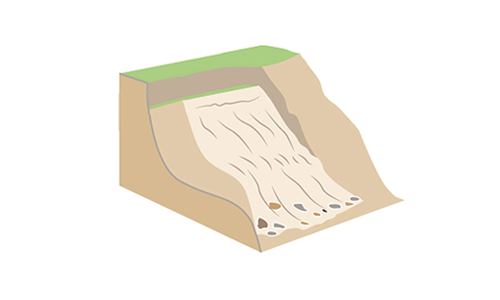.png)
Translational
Where a landslide occurs along the surface of a fault, joint or bedding plane, it is said to be translational or ‘planar’. Often causing huge damage, translational landslides can result in the rapid movement of material down a slope. The speed of the slide ultimately depends on how deep the underlying fault is.
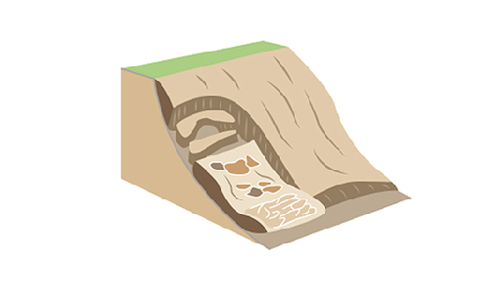
Flows
If water – or another form of fluid – is involved, then a flow can occur. This is a movement of fluid along with any other material that is being carried in it. A flow could consist of mud, debris or even rock (known as a rock avalanche).
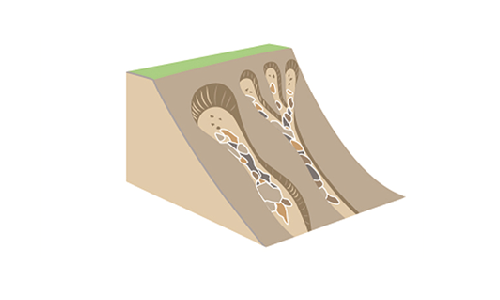
What causes a landslide?
Landslides are caused when natural or human-related activities disturb unstable slopes. Factors like heavy rainfall, earthquakes, volcanic activity, or human activities such as mining or construction can act alone or together, disrupting the earth’s layers and leading to slope instability.
As a result, the weight, angle, geometry and strength of the external force can place pressure upon the internal shear strength of the soil, leading to stability failure, which causes a landslide. Factors such as the particle size of soil, moisture content, and density also influence how the soil resists these external stresses.
Let’s take a deeper look into the different causes of landslides:
Water
Water plays an integral part in the many causes of landslides and is the most common cause of a landslide trigger mechanism. Soil that is already facing instability can be at risk of sliding when water increases the hydrostatic pore pressure while weakening the soil. In extreme cases, excessive saturation can lead to soil liquefaction, a condition where the soil temporarily loses its strength and behaves like a liquid, drastically reducing its ability to support loads. An increase in water can originate from a number of natural causes and other human-related activities, including rainfall, snowmelt, stream erosion, burst water mains, and floods.
Soil strength and slope angle
Different soil types can support different slope angles. The maximum stable slope face angle depends upon the internal strength of the soil and the forces acting on it. In granular soils, the way particles behave during shearing, also referred to as sand dilatancy, can greatly impact slope stability. When sand particles move and rearrange under stress, the soil might expand or contract, changing pore water pressures. Some slopes that have been stable for many years can suddenly fail due to a trigger mechanism such as a change in soil strength or surcharge loading.
External activity
A landslide can be caused by several external factors other than water and soil stability. Primarily, earth vibrations such as earthquakes, volcanic eruptions, and human activity (mining or traffic) are the obvious causes. A slope’s strength can also be impacted by the removal of vegetation and weathering, where a material’s strength is reduced due to freeze thaw cycles and mineralogical changes, and the arrangement of the rock layers.
The varying effects of landslides
The effects of landslides are vast, occurring in all regions across the globe with varying degrees of severity that can have a widespread environmental, economic and social impact.
Many landslides are minor slope failures with minimal consequences, where even local people may be unaware of their occurrence.
At the other end of the scale are the humanitarian disasters caused by severe landslides which involve the catastrophic loss of life and destruction of vital infrastructure and utilities. In extreme cases, the secondary effects of a landslide may include flooding, contamination of water sources and seismic activity which can further their environmental, economic and social impact.
In between these extremes are a variety of landslide types, including both minor and major failures, resulting in differing degrees of damage to buildings, properties, businesses, people, and animals.
Landslide prevention techniques
The easiest way to prevent a landslide is to avoid building in areas that are or might become prone to landslides. However, when this is not always an option, unique assessments are often used to show that the conditions for a landslide exist.
In such cases, landslide prevention measures can be taken to reduce the potential for a landslide to occur, such as steep slope reinforcement, installing structures using pile foundations, checking surface drainage and utilising vegetation cover to provide natural anchorage and reduce soil moisture levels.
Slope stabilisation
Slope stability is the cornerstone of landslide prevention. A common and robust technique is the construction of retaining walls. These structures are designed to counter the pressure of the soil behind them, preventing it from moving downhill. Retaining walls can be built from various materials, including concrete, stone, and timber, and are particularly effective for steep or high-risk slopes.
In modern civil engineering, geosynthetics have emerged as a highly versatile and cost-effective solution for slope stabilisation. These synthetic materials, such as geogrids and geotextiles, are laid within the soil layers to provide tensile strength and reinforcement. They essentially "tie" the soil together, increasing its shear strength and preventing it from sliding. This method is especially useful for creating stable, steeper slopes than would otherwise be possible and can significantly reduce the need for traditional, more expensive earthwork.
Improve surface drainage
Surface drainage can be installed to reroute surface water away from a slope, thus reducing the likelihood of a landslide. In high rainfall areas, erosion protection via surface drainage – both at the slope’s toe and on the surface – can be highly effective. This helps to positively impact the maintenance of the angle of the slope. An alternative option is almost the opposite of this, where removing material from the top of the slope or adding a toe berm can reduce the effective slope angle and loading, thus reducing the risk of a landslide and increasing safety.
Construction of safe steep slopes
Sometimes it is desirable to construct earth slopes or embankments with steep faces. Steep slopes reduce land take and are lower in cost than constructing vertical retaining walls. The steep slope can be made stable and prevent landslides by the inclusion of soil reinforcement in the form of high-strength geogrids, such as the Tensar Basetex. Tensar has developed systems for the design and construction of reinforced soil slopes with face angles of up to 70°: TensarTech Natural Green and TensarTech GreenSlope.
Ultimately, the only way to increase the strength and stability of slopes prone to landslides is by major engineering works. Several options are available, including soil nailing and earth retaining structures.
Landslide mitigation strategies
Landslide mitigation strategies are actions taken to reduce the potential for damage, injury, or loss of life from a landslide. While landslide prevention focuses on preventing a landslide from occurring, mitigation involves preparing for and managing an event if it does happen.
- Warning systems: This is one of the most critical mitigation strategies. Early warning systems are designed to detect signs of impending slope failure and provide timely alerts to at-risk communities.
- Physical protective barriers: Retaining walls are one of the most common types. Constructing this solution early at the base of slopes or in areas where landslides are likely to occur can have a significant impact on mitigating landslides.
- Land-use planning and zoning: This is a non-structural but highly effective mitigation strategy that involves proactive planning to avoid placing people and critical assets in high-risk zones.
- Public education and preparedness: A well-informed community is a resilient one. There is a shared responsibility between governments, non-governmental educations, and educational institutions to teach the public about landslide risks and how to respond effectively.
Repair of failed slopes
Landslides affecting infrastructure are not an uncommon occurrence, as roads and rail embankments can slide, and steep-faced cuttings in soil and rock can fail. Where landslides occur in embankments or soil cuttings, the failed material is often removed from the site and replaced with a material that has greater strength, usually quarried rock or aggregate. This is expensive and disruptive, and not ideal.
An alternative approach to landslide repair, first introduced in the 1980s, involves the reuse of the failed soil material, incorporating soil reinforcement in the form of Tensar geogrids. This solution has been widely used across the globe for the reinstatement of failed slopes and landslides in highways, rail, and other infrastructure works, both in urban and rural areas. The TensarTech Slope Repair System includes design advice and support from Tensar’s experienced design team and our Tensar+ geotechnical software.
Next steps
This guide has explained what a landslide is, the different types of landslides, the varying effects, how to prevent them, and how failed slopes are repaired. If you’ve found this post useful, you may also want to read some of our other articles:
To find out more about how Tensar products support slope design and construction processes, visit our Tensar geogrids and geosynthetic construction solutions pages.
Got a burning question about geotechnical engineering?
Whether you’re curious about geotechnical engineering, retaining wall systems, slope stability, or Tensar solutions, we’re here to help. Contact us or email us at info@tensar.co.uk for any questions or inquiries.



.png?width=400&height=400&ext=.png)